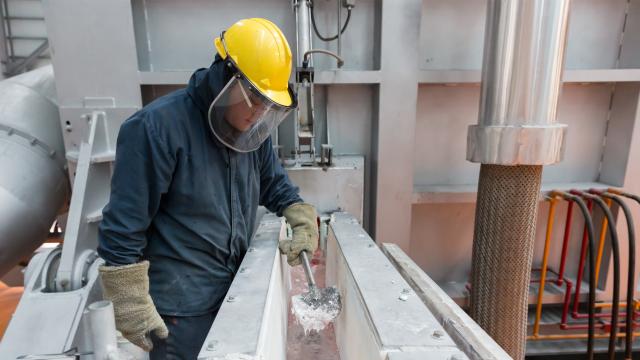By 2030, Apple has promised to make its products and supply chain carbon-neutral. That’s a lot of work to accomplish in fewer than 10 years, especially for a company responsible for a whole lot of extractive and energy-intensive products.
As part of this commitment, the tech company is helping develop the world’s “first-ever direct carbon-free aluminium smelting process.” Aluminium production makes up about 1 per cent of the world’s greenhouse gas emissions: 400 million tons of carbon emissions a year. Should Apple actually discover a way for the smelting process to emit oxygen instead of greenhouse gases, that’ll be a gamechanger for the carbon footprint of not only gadgets but potentially the construction and transportation industries. That’s a big if, and Apple hasn’t been super forthcoming about exactly how its aluminium will achieve carbon neutrality from mining to refining.
Apple’s announcement last week is only the latest in the company’s attempt to clean up its supply chain and energy use. In 2018, the company announced it would use 100 per cent recycled aluminium and declared it was going 100 per cent renewable. However, as long as the company is selling hundreds of millions of products that are notoriously impossible to repair, the company is doing the planet a disservice by producing more stuff.
That being said, this new method of producing aluminium would be revolutionary if Apple indeed succeeds. Aluminium production alone makes up a quarter of the company’s carbon footprint. The tech company is working with two of the world’s leading aluminium manufacturers, Alcoa and Rio Tinto, which have created a partnership they’ve called Elysis where all these players can come together to research and create carbon-free aluminium. This partnership kicked off in 2018 with the goal of having the tech ready by 2024, well in line with Apple’s 2030 goal of carbon neutrality.
If you have no idea how this process works, let me break it down. Aluminium comes from bauxite. Producers use electricity to break the rock down to become aluminium. The process involves the use of carbon anodes, which are essentially carbon blocks that conduct electricity. These blocks are made out of, as the name suggests, carbon! This process requires a ton of energy and, thus, results in a bunch of greenhouse gas emissions, including perfluorocarbons, which is an even more potent greenhouse gas than carbon dioxide (it also releases carbon dioxide as well). The process can also release other pollutants into the air, such as sulphur dioxide. In short, aluminium production is bad for the planet and public health to say nothing of human rights concerns around bauxite mining.
So if Apple and friends have figured out a way to transform part of the process, that’s pretty dope. Elysis has been producing this so-called carbon-free metal at its centre near Pittsburgh since 2009. The group is now trying to scale this technology up so that it can meet the demands of players like Apple.
However, Apple and Elysis were cagey about the process and how they’re assessing the environmental impacts and claims of carbon-free production. In fact, this very story is running more than a week later than we would’ve liked because Gizmodo kept trying to get clear answers from both players to no avail.
Elysis doesn’t provide much info on how this process releases oxygen instead of greenhouse gases, only noting it would replace the use of carbon anodes in the aluminium smelting process. It doesn’t share any information on what the blocks are replaced with or how this new process works. This is to protect its research and proprietary info, but that does make me a bit sceptical. Sometimes, in an effort to clean up one mess, companies wind up creating another.
The company is also only calling its smelting process “carbon-free.” That doesn’t mean the entire production of the aluminium Apple purchases will be though it should be “carbon neutral” by 2030. Gabrielle Gaustad, the dean of Alfred University’s Inamori School of Engineering, told Gizmodo that’s an issue. This new process would be a “massive technological step forward,” but this carbon-free tag may be “misleading,” she said. Pittsburgh, where this research is happening, is plugged into a grid that still relies on coal power, which is among the dirtiest sources of energy.
“The issue with calling this aluminium “˜carbon-free’ is that they don’t account for the processes further up the supply chain it seems,” Gaustad said.
When Gizmodo asked Elysis specific questions around whether the Pittsburgh facility is run on clean energy, it did not answer them. It also didn’t address whether the carbon anode replacement has been vetted for other environmental consequences or whether they feel confident that this alternative won’t create new issues.
Apple, too, didn’t answer any specific questions Gizmodo asked. Instead, it copy and pasted some 2,299 words from its environmental reports and white papers to highlight all that it’s doing to generally make its supply chain carbon neutral. It failed, however, to offer specifics on how it will deal with sources of emissions outside the smelting process or if that Pittsburgh facility runs on clean or renewable energy. Instead, it pointed to its reliance on less aluminium and recycled aluminium for its products. All great points, but Apple didn’t answer the specific yes-no type answers Gizmodo asked about the process and how it would account for emissions.
It’s great to see major companies using their platforms and scientific know-how to find alternatives to the climate crisis, but you know what would be greater? If they were more transparent about the alternatives they’re working on. Oh, and also not creating a system of obsolescence, taking away people’s right to repair, and pushing more consumption in the first place. If we produced and consumed less stuff, then the environmental crisis we’re now facing would not be the crisis it has become in the first place.
